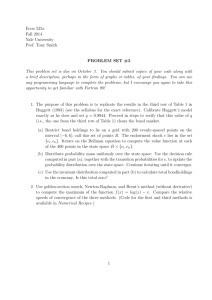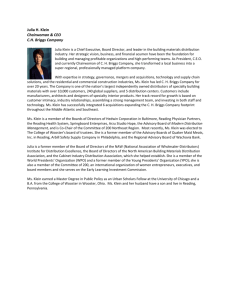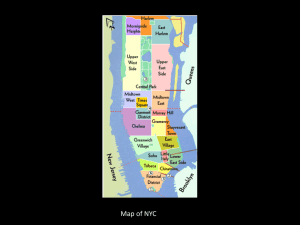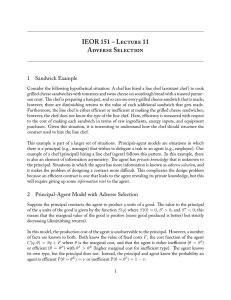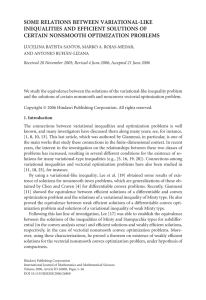Tentative course outline
advertisement
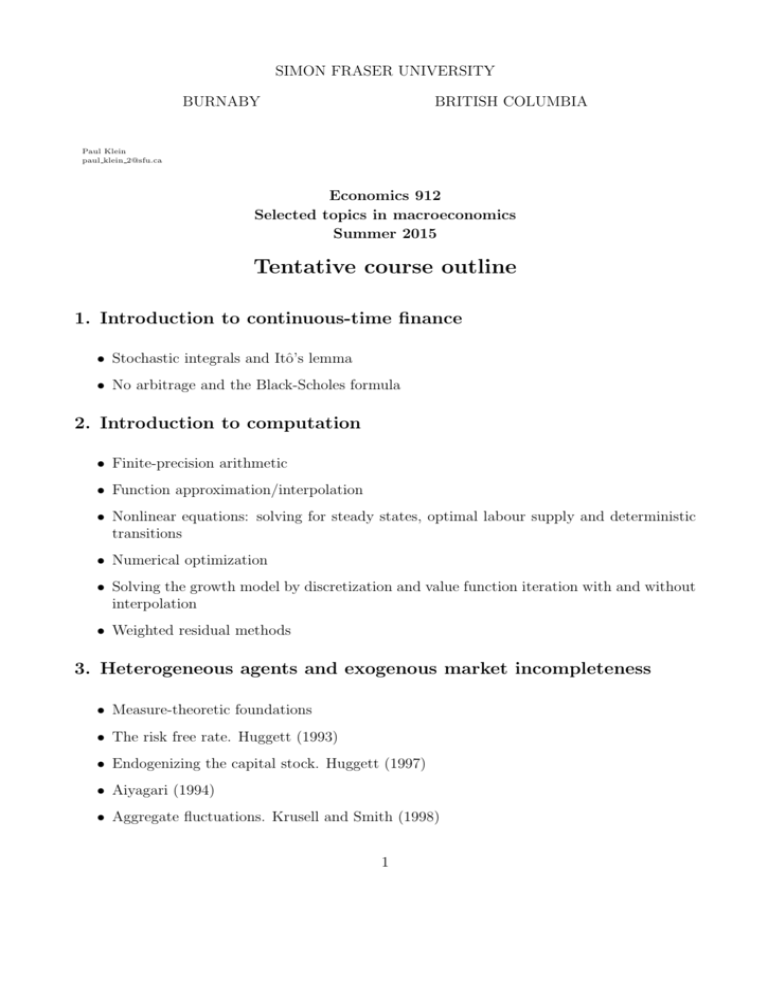
SIMON FRASER UNIVERSITY BURNABY BRITISH COLUMBIA Paul Klein paul klein 2@sfu.ca Economics 912 Selected topics in macroeconomics Summer 2015 Tentative course outline 1. Introduction to continuous-time finance • Stochastic integrals and Itô’s lemma • No arbitrage and the Black-Scholes formula 2. Introduction to computation • Finite-precision arithmetic • Function approximation/interpolation • Nonlinear equations: solving for steady states, optimal labour supply and deterministic transitions • Numerical optimization • Solving the growth model by discretization and value function iteration with and without interpolation • Weighted residual methods 3. Heterogeneous agents and exogenous market incompleteness • Measure-theoretic foundations • The risk free rate. Huggett (1993) • Endogenizing the capital stock. Huggett (1997) • Aiyagari (1994) • Aggregate fluctuations. Krusell and Smith (1998) 1 4. Linear and quadratic approximations • Klein (2000) • Gomme and Klein (2008) 5. Endogenous imperfect risk sharing • Limited enforcement – Kehoe and Levine (2001) – Kocherlakota (1996) – Kehoe and Perri (2002) – Krueger and Perri (2006) – Krueger and Uhlig (2006) – Bold (2009) • Moral hazard – Thomas and Worrall (1990) – Atkeson and Lucas (1992) – Atkeson and Lucas (1995) – Phelan (1995) – Fernandes and Phelan (2000) – Wang (1995) – Smith and Wang (2006) 6. Endogenous size distribution of firms • Hopenhayn (1992) • Hopenhayn and Rogerson (1993) • Veracierto (2001) • Guner, Ventura, and Yi (2008) 2 References Aiyagari, S. R. (1994). Uninsured idiosyncratic risk, and aggregate saving. Quarterly Journal of Economics 109, 659–684. Atkeson, A. and R. E. Lucas (1992). On efficient distribution with private information. Review of Economic Studies 59, 427–453. Atkeson, A. and R. E. Lucas (1995). Efficiency and equality in a simple model of efficient unemployment insurance. Journal of Economic Theory 66 (1), 64–88. Bold, T. (2009, 03). Implications of Endogenous Group Formation for Efficient Risk-Sharing. Economic Journal 119 (536), 562–591. Fernandes, A. and C. Phelan (2000, April). A recursive formulation for repeated agency with history dependence. Journal of Economic Theory 91 (2), 223–247. Gomme, P. and P. Klein (2008). Second-order approximations of dynamic models without the use of tensors. Manuscript. Guner, N., G. Ventura, and X. Yi (2008, October). Macroeconomic Implications of SizeDependent Policies. Review of Economic Dynamics 11 (4), 721–744. Hopenhayn, H. (1992). Entry, exit, and firm dynamics in long run equilibrium. Econometrica 60 (5), 1127–1150. Hopenhayn, H. and R. Rogerson (1993). Job turnover and policy evaluation: A general equilibrium analysis. Journal of Political Economy 101 (5), 915–938. Huggett, M. (1993). The risk free rate in heterogeneous-agents, incomplete insurance economies. Journal of Economic Dynamics and Control 17 (5/6), 953–970. Huggett, M. (1997). The one-sector growth model with idiosyncratic shocks: Steady states and dynamics. Journal of Monetary Economics 39 (3), 385–403. Kehoe, P. J. and F. Perri (2002). International business cycles with endogenous incomplete markets. Econometrica 70 (3), 907–928. Kehoe, T. J. and D. Levine (2001). Liquidity constrained vs. debt constrained markets. Economica 69, 575–598. Klein, P. (2000). Using the generalized Schur form to solve a multivariate linear rational expectations model. Journal of Economic Dynamics and Control 24 (10), 1405–1423. Kocherlakota, N. R. (1996). Implications of efficient risk sharing without commitment. Review of Economic Studies 63 (4), 595–609. Krueger, D. and F. Perri (2006). Does income inequality lead to consumption inequality? Evidence and theory. Review of Economic Studies 73, 163–193. Krueger, D. and H. Uhlig (2006). Competitive risk sharing contracts with one-sided commitment. Journal of Monetary Economics 53 (7), 1661–1691. Krusell, P. and A. Smith (1998). Income and wealth heterogeneity in the macroeconomy. Journal of Political Economy 106, 867–896. 3 Phelan, C. (1995). Repeated moral hazard and one-sided commitment. Journal of Economic Theory 66, 488–506. Smith, A. A. and C. Wang (2006). Dynamic credit relationships in general equilibrium. Journal of Monetary Economics 53, 847–877. Thomas, J. and T. Worrall (1990). Income fluctuations and asymmetric information: An example of a repeated principal-agent problem. Journal of Economic Theory 51 (2), 367– 390. Veracierto, M. (2001, August). Employment Flows, Capital Mobility, and Policy Analysis. International Economic Review 42 (3), 571–95. Wang, C. (1995). Dynamic insurance with private information and balanced budgets. Review of Economic Studies 62 (4), 577–595. 4
